A Botanical Hedgehog In My Garden
Monday, July 31, 2006


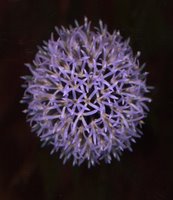
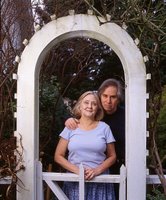
It seems I cannot get away from thinking of spiny things. Perhaps it has to do with the fact that I have recently re-read one of my favourite novels, Yevgeny Yevtushenko's Don't Die Before You're Dead. One of the protagonists, Chunya, is a hedgehog. And is just so happens that the botanical name of our globe thistles, Echinops means "like a hedgehog" in Greek, refering to the spiny flower bracts. No matter how hard I try, my wife Rosemary is always ahead in locating interesting plants. Some years back I could not understand her interest in hardy geraniums and I absolutely loathed the smell of her Astrantia major 'Shaggy'reminiscent of sweaty armpits in a Mexican second class bus in summer. I now, of course, love these plants and admire Rosemary's ability to appreciate plants that are subtle. It was about 8 years ago that she showed interest in the globe thistle and brought home some blue ones called Echinops ritro 'Veitch's Blue' I did not understand what she saw in these plants that were reminded me of the cardos or thistles of the Argentine pampa. Then I saw how bees were attracted to the flower and how tall these plants grew in the back of the border. So I liked them, too. Four or five years ago I picked up something called Echinops sphaerocephalus 'Artic Glow'. I told Rosemary they were supposed to be white. She showed no interest. I forgot the plants. Then this year I spotted these incredible spiky white balls in the back of our sunny perennial border. Yes! Just this time, I may have discovered a good plant before Rosemary. I have a good teacher.
Andrea Y El Baile De Las Sábanas Blancas
Sunday, July 30, 2006

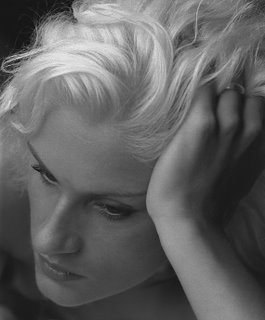
A few years ago some freelance writers and photographers would meet on Thursdays for lunch at the Railway Club on Dunsmuir and Seymour. An infrequent apparition was a beautiful, shapely and tall blond woman who sat at a nearby table. All we could do was to spy glances as we did not have enough nerve to invite her to sit at our table. I looked forward to those days when she did show up. One day I decided that all she could do was say, "No." So I went up to her and asked, "I would like to photograph you undraped." She looked at me straight in the eye and responded, "I would be delighted."
I anticipated our afernoon appointment at my studio with pleasure. She arrived and she unceremoniously took her clothes off. I was speechless. She had had a mastectomy, she had an appendix scar and two C-section scars. I did not know what to do. Now, of course, I would photograph her as she is. That time around I worked around the "problems". One of the photographs, El Baile de las Sábanas Blancas(above, left) is one of my favourite and most sensual photographs. The title means, "the white sheet dance or ball". As a little boy I would fight going to bed and my mother would say, "Alex, es la hora de ir al baile de las sábanas blancas." This dance of the white sheets, was my bed. I have never forgotten the expression, and even now I would not sleep in anything but crisp white sheets.
And often when I despair at not being rich like a plumber, I do come to accept that being a photographer does have a few advantages.
Charles Darwin & The Cardoon
Saturday, July 29, 2006
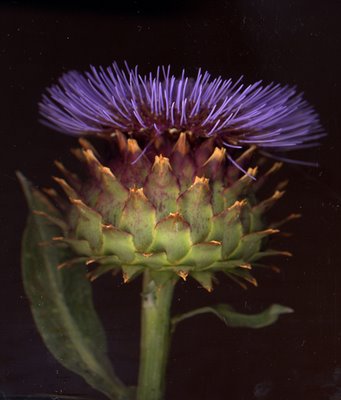
In my garden my Rosemary grows several Cyanara cardunculus. These stately (8 to 9 ft tall) thistle-like plants have flowers (above, and cut from today's garden) that resemble thistles and leaves that resemble the leaves of the Acanthus, the plant that the Greeks used as models for their Corinthian column capitals. But Cynara cardunculus is not a thistle it is a close relative of the artichoke or Cynara scolymus.
In his Voyage of the Beagle Charles Darwin describes the Argentine pampas around 1833.
"But the cardoon (Cynara cardunculus) has a far wider range. It occurs in these latitudes on both sides of the Cordillera, across the continent. I saw it unfrequented spots in Chile, Entre Rios[an area North East of Buenos Aires]and the Banda Oriental [modern day Uruguay]. In the latter country alone, very many (probably several hundred) square miles are covered by one mass of these prickly plants and are impenetrable by man or beast. Over the undulating plains, where these great beds ocurr, nothing else can now live."
It seems that in Darwin's time there were areas not yet populated by the cardoon which was a plant brought to America by the European colonizers. This is an example of a non native and agressive plant that destroyed and replaced some of the original herbage of the Argentine pampa. But in my journey through the pampas in the 50s, 60s I don't recall seeing the cardunculus in mass. All I saw was the cardo (as Argentines call) the really prickly thistle of the pampas. I decided to look it all up and I found out that Europeans in the 1920s brought the Scotch thistle or Onopordum acanthium with them. This real thistle, much more agressive than the cardoon, has systematically taken over. I had a Scotch thistle in our garden a couple of years ago. I found it beautiful. But I would agree with Rosemary that Darwin's (as I call it now) cardoon is far more beautiful. When I gaze on it I can imagine Darwin galloping with his friend, Argentine strongman Juan Manuel de Rosas in search of fast Argentine ostriches.
Abraham, Lauren, Cucumber Sandwiches & A Horsie
Friday, July 28, 2006
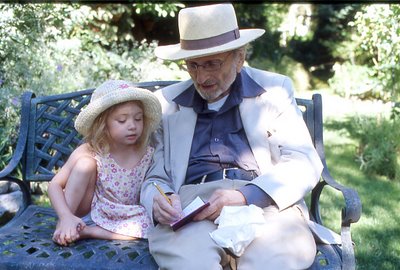
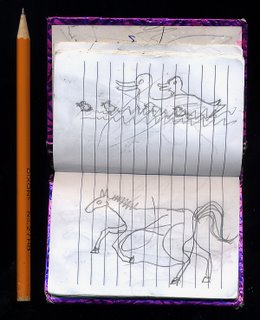
I had not seen my friend Abraham Jedidiah Rogatnick for a couple of months so I called him on Wednesday morning and asked him if he wanted to come over for tea. Abraham at 83 manifests all the impulses of the young man that he is, and said he would be over at four.
I sliced a cucumber very thin and soaked the slices in a bowl of water with lots of sea salt and sugar. I made some mayonnaise and put four eggs to boil. In nearby Kerrisdale, at Moore's Bakery, I bought a loaf of white bread, sliced extra thin, for my cucumber and egg salad sandwiches. I also bought some cookies. Rosemary came back from Safeway with very good cherries (I placed them in a bowl with lots of ice) and a watermelon. The secret of my cucumber sandwiches is that I coat one slice of bread with unsalted butter and the other with my homemade mayonnaise. And I always put Coleman's mustard, celery, onion and red pepper in the egg mix.
When Abraham promptly arrived I asked him if he wanted organic Tanzania or Earl Grey tea. He opted for the second when I told him that the Tanzania tea was very strong and would help grow more hair on his chest. We went down to the garden and sat down for tea. Lauren (4) took a liking for Abraham and sat next to him. She sat closer when I threatened to spit cherry pits at her. She asked Abraham to draw her a horsie, some ducks, a birdie and a giraffe. This Abraham did.
Abraham
Memphis Britannica - Tlön, Uqbar, Orbis Tertius
Thursday, July 27, 2006
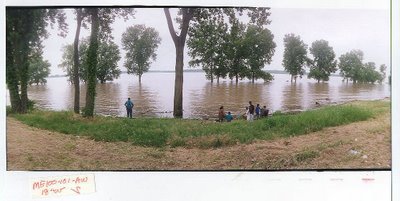
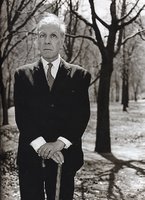
It is not generally known that Borges wrote what could be technically seen as speculative fiction. He wrote Tlön, Uqbar, Orbis Tertius around 194O and it appeared in the Argentine journal Sur, May, 1940. The story has a postcript dated 1947.
As Google becomes the defining reality of what exists and what doesn't, I wonder how Borges might have tinkered with our on-line world in his fiction. I have been often intrigued by looking for people or events that I know existed or exist and drawing a blank from Google. Or even more troubling when I get a notification that the web page I am looking for is no longer available.
In the Borges story, he is having dinner and chatting with his long time friend, writer Bioy Casares, in a summer ( those that can, rent quintas to escape the heat of Buenos Aires) rented estate in the Buenos Aires suburb of Ramos Mejia. They spot a mirror and they share their idea that mirrors distort. Casares quotes a heretical scholar from the country of Uqbar who said that mirrors and copulation are abominable because they multiply the number of men. Borges is interested and asks Casares for the origin of the quote. Casares cites The Anglo-American Cyclopedia (New York, 1917). The friends found a set of the encyclopedia (in itself a copy of the 1902 Encyclopedia Britannica)and in the last pages of volume XLVI they locate Upsala but there is no Uqbar. The next morning Casares calls up Borges and tells him, that indeed, in his copy of the Cyclopedia, and in Volume XLVI there is a reference to Uqbar. This volume mysteriously had 921 pages instead of the 917 they note in a copy at a bookstore on Calle Corrientes.
To be brief, it is suffice to note that in this longish story, a first-rate bibliographical maze (one of the author's longest short stories) Borges reveals to us that a journalist from the Nashville paper The American discovers in the Memphis Public Library in 1944, the 40 volume set of the First Encyclopedia of Tlön. Tlön is an apparently fictitious (or maybe, not) planet (with a country called Uqbar) and, "If our forecasts are not in error, a hundred years from now someone will discover the hundred volumes of the Second Encyclopedia of Tlön.
Then English and French and mere Spanish will disappear from the globe. The world will be Tlön."
I took this picture in Memphis on the banks of the Mississippi and not far from the Pyramid. I have been recently seeing this scene in my dreams where the portly black man on the left turns around and I see instead Diane Arbus's remakable portrait of Borges (top, right) taken in New York's Central Park.
The Birkenstock Man From Curacao
Wednesday, July 26, 2006
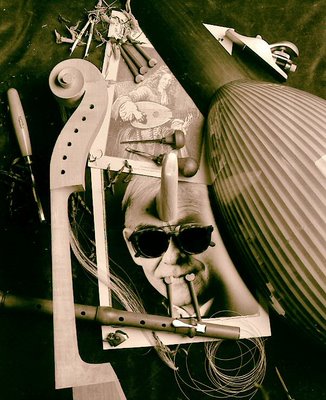
José Verstappen, the executive director of Early Music Vancouver, is the coolest man around. Rain or shine, winter or summer, the man wears socked Birkenstocks. I swear I once saw him walking on 7th Avenue (near EMV's headquarters on Hodson Manor)in shoes because it was raining. Mr. Verstappen refutes my version categorically.
Verstappen, a Renaissance man (he does the web site design, the publicity, the typography, probably vacuums, too) with the help of that other Rennaissance man, Ray Nurse( baritone, lutenist, lute maker, etc) has steered the organization (for 26 years since its founding) into the success that it is today. EMV has brought the best baroque groups from around the world and employed local baroque musicians as teachers and performers in UBC's Vancouver Early Music Programme & Festival. Starting in smaller venues as the much maligned (I loved it!) Metropolitan Tabernacle, EMV can now routinely fill the Chan Centre.
But for me, Verstappen has pushed what many consider the normal boundary of the baroque period (the 18th Century) so that through groups like Ray Nurse's La Cetra we are now exploring Bach's early cantatas and listening to composers of the fantastic period of the 17th Century. With the help of local virtuoso violinist Marc Destrubé EMV is also exploring the period immediately after the baroque with performances of Mozart, Hayd, and Beethoven in period instruments.
Verstappen, the cool man, has brought us downloadable concert programs with extensive information on what you are going to listen to. His beautiful Early Music Vancouver Calendar (particularly useful as it runs from July of one year to June of he next) graces our fridge with the help of one stout Lee Valley magnet. But best of all EMV promotes the idea that young people should attend concerts. Any adult can bring a youth for free. I wish such organizations as Ballet BC and the VSO adopted similar plans.
The paradox, the wonderful paradox, is that thanks to José Verstappen and his EMV when I go to one of their concerts I am magically transported back to the time when this music was exciting and new and had never ever been played before.
Late happening adendum courtesy of José Verstappen: I need to indeed refute your comment on me wearing shoes because it was raining; the only occasion I sometimes forget my Birckenstock loyalty is when there is slush after a heavy snowfall.
Early Music Vancouver
Little Dancer, Aged 14
Tuesday, July 25, 2006

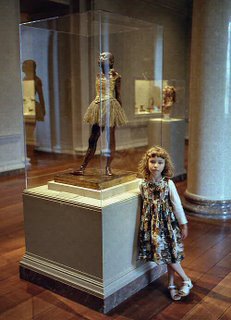
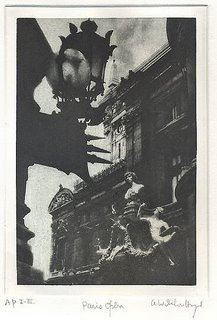
In April 16, 1881 Edgar Degas's wax sculpture of "Little Dancer, Aged 14" was shown in the Sixth Impressionist exibition in Paris. Paris was in an uproar. Journalists questioned the morality of the little girl and her relationship with the chaste Degas. Newspapers did not name Marie van Goethem (born in 1865 into a Belgian family newly settled in Paris) who stood before them in a real tutu and real ribbons in her real horsehair wig. Marie had been connected with the Paris Opéra Ballet soon after it opened in its new building in 1875. In 1882 Marie was abruptly fired from the Opéra after missing 11 classes and after newspapers cited her as a habitué at the Rat Morte and other dives. Her ultimate fate after 1982 is unknown.
In June 1994 I visited the National Gallery in Washington DC and Rebecca posed by one, of the 28 or so posthumous existing bronze casts of the Degas work.
Soon after I met Ballet BCs Sandrine Cassini and I was immediately affected by her presence, particularly when she told me she had danced for the Paris Opéra Ballet. Before she left for Europe she posed for me in my studio as an older Marie van Goethem.
The Decisive Moment
Monday, July 24, 2006
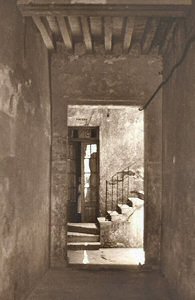
Every few years the folks at a local art institute have a brilliant idea. They put forward the scheme that they can save lots of money by assigning photography students to take the photographs for the school's brochure and or web page. So students go into a life drawing class and the smell of paint inspires them as does the texture of the charcoal drawings or the oils. But when these photographs reduce the three dimensions into two, they don't look so exciting and, worst of all, you cannot smell the paint. So for some rare ocasions commercial photographers are hired (I was, twice) to take the photographs.
There is a reason why so many of the photographs are disappointing. It has to do with waiting for Henri Cartier-Bresson's decisive moment. Cartier-Bresson had all the time in the world when he sat in Paris cafes with his black-taped Leica under the table ready for the moment. Students have less patience and things just don't happen.
As an example, when I saw this zaguán (passageway)in Mexico City many years ago I was intrigued. So I ran in, rang the bell and ran out and waited.
Sometimes decisive moments are created.
A Hot South American Summer
Sunday, July 23, 2006
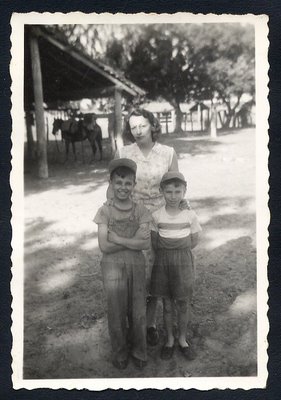
Over the intense chattering of the cicadas I heard Tía Sarita, one hot siesta afternoon of a South American summer in 1952. From my bed, enveloped by a white mosquito net, I heard her whisper to my mother, "Nena, Alex and Wenceslao are almost of age. Next year we'll have them lie with an india so they will become men." When it cooled, we were awakened for cool watermelon. It had been lowered into a well after lunch. I was nine.
Tia Sarita and my Uncle Tony de Irureta Goyena, with their son Wenceslao, had invited my mother and me to join them on a paddlewheeler, the Guarani, that went up the Paraná River from Buenos Aires to Goya, in the northern, sub-tropical province of Corrientes. From Goya we drove inland at night, to escape the heat, in a flat-bed "Estudevaquer". We were on our backs, the hay beneath us doing little to lessen the bumping of the nonexistent road. Above, the via láctea streaked across the sky, white, like rows and rows of trees that line the boulevards of Buenos Aires, their trunks painted with lime. It was then that I first noticed the Southern Cross.
My siesta was in Santa Teresita, an estancia owned by Tia Sarita's widowed aunt Raquel and her spinster sister Abigail. They were always in black, in perpetual mourning for Raquel's Fernando. From the estancia, a day's ride on a horse in any direction marked the boundaries of Raquel's cattle ranch. It was run like a kingdom, hers.
Looking back on our daily routine at Santa Teresita I now realize it was anything but that. In the morning we swam in the nearby Rio Corrientes, but only after Sixto, the foreman, had splashed around on a horse. The smell of horsflesh allegedly spooked the piraña and the yacarés (alligators) wanting to spoil our fun. Wenceslao (left in photo above with Sarita. I'm the blond one.) and I would often ride in search of the ñandú, the South American cousin of the ostrich. It would have never ocurred to us to eat one nor did we know then that someday the finest wallets and boots could be made from their hide. The swift but dumb bird was killed for its tail feathers which were made into plumeros or dusters exported to the world until vacuum cleaners saved the ñandú from extinction. When we spotted its huge eggs we would gingerly return home with them. The egg, equivalent to a dozen hen's eggs had a very strong smell that Argentines call catinga.
Wenceslao and I would place 3 or 4 sheepskins on our matungos (nags) and cinch them up. This and stirrups is the Argentine saddle. We would ride into the pampa where the ñandú would suddenly run from behind the thistles and the cardoons. We would gallop in hot pursuit swinging our boleadoras fashioned from croquet balls and rope. We never did fell one but we knew that behind the thistles, where the bird had emerged , we would find eggs. The peones or workers in the estancia made cakes and milanesas (breaded veal cutlets) with them. The catinga was so strong we politely rejected all offers.
Of all the workers, Sixto spoke the best Spanish. The rest spoke Guaraní, the melodious language of North Eastern Argentina, Paraguay and Southern Brazil. Consider jacarandá, which correctly pronounced, hacarandá, with a stress in that last syllable, may be one of the sweetest sounding words of all.
Because of his position, Sixto had the finest facón (knife) and mate gourd. from which he sipped his mate. He owned a pair of boots whose canes were pleated to imitate the bellows of the bandoneón. One day he asked permission to speak to my Uncle Tony. The workers wanted more money and would not work from sunup to sundown until their demand was met. Sixto wanted my uncle to intercede. Tia Raquel was adamant about not caving in. Uncle Tony brought all the workers together. He played some Andean music with his recorder and sang songs in Tagalog. Both my mother and he had been born in Manila. Then, treating them like children, he told them the story of the goose that lay the golden egg in his finest Guaraní . Fascinated, they listened to every word. They dispersed and went back to work.
That evening a few cows were slaughtered and an asado was given them by Raquel. Later in the night the workers danced to the Chamamé a Correntino dance. The singing got louder as the effects of the aguardiente took its toll. The next morning Sixto did not ride into the Rio Corrientes. He had been banished for knifing a fellow worker in a fight. The fellow had borrowed his mate without asking. The banishment meant that although Sixto would probably give the authorities a slip he would have to be on the run as a matrero or outlaw.
I never did return to lie with an India having to become a man in the more conventional way. But all it takes is an intense summer heat to fondly remember watermelons, Wenceslao and the Southern Cross.
Baroque Violinists, Thunderbirds & A Folly
Saturday, July 22, 2006


About 20 years ago, for a short while, I considered becoming a movie stills photographer. The stills photographer shoots pictures during the production of a movie. Towards this end I plunked down around $1600 for a used Nikon 200mm F-2 lens. It is a very big lens designed to be used wide open.
I never became a stills photographer nor did I ever shoot fashion on Robson Street. For fashion, this lens, with its very narrow depth of field, would be useful.
But I have used this lens to photograph the Pacific Baroque Orchestra in rehearsal (here, Marc Destrube) and once to get this lineup of the the US Airforce Thunderbirds. Perhaps I should sell the lens. But I prefer to keep it as a folly. And I never know when I might just have to photograph another rehearsal or perhaps even the US Navy Blue Angels.
Carole James & Hilary Stewart
Friday, July 21, 2006
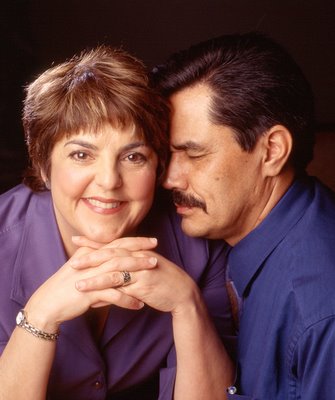

The folks at Skunkworks have done a grand job of designing my web page. Besides being good graphic designers they are also lawyers. Lawyers have (when they have one) an odd sense of humour. So when they were building my web page they placed Carole James and her husband Al Gerow on the same page as Cicciolina.
Now Communications, the agency that hired me to photograph Carole James, the head of the New Democratic Party in British Columbia, might have objected to the pairing even if the principal at Skunkworks, Doug Jasinski, pointed out that both were politicians, both were women and both were lef-wing. I was not convinced so I insisted on a change. And so they posted the picture of my then two-year-old daughter Hilary Stewart (the mother of Rebecca and Lauren who are often seen here). Hilary is now 34.
Sidney Poitier, Winston Miller & Angels In America
Thursday, July 20, 2006
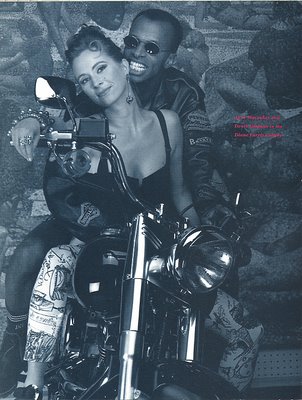
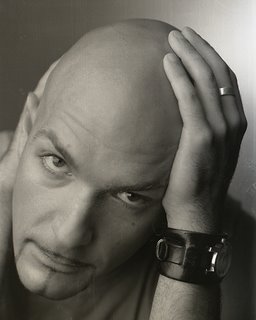
Many years ago my doorbell rang and I opened it to Sidney Poitier. That was my first impression. I again looked carefully, and the handsome an urbane black man in the perfect suit, was Winston Miller, who upon leaving my house became my life insurance agent with Transamerica. The clincher was his radio voice.
Some years ago I had met another slimmer version of Sidney Poitier. Actor Denis Simpson was on a Harley Davidson with Anne Macaulay (of the latter, John Lekich, author and movie critic, said, "She was the only woman I ever met whose chest blushed.") I was taking a series of photographs for an art magazine called Step that featured local celebrities on Harleys.
And I should have known that I was up for a treat when I got off the B-Line Bus on the Granville St Bridge. I ran into the Electric Light Company's Kevin Kerr. Both of us were headed for the premiere performance of Angels in America at the Waterfront Theatre on Granville Island. I asked Kerr about one of the performers, Sarah Rodgers. Kerr, with a smile on his face, told me of Rodgers's other talent, "She is a terrific director."
But nothing prepared me for Denis Simpson's performance. I am sure that the other characters will have their opportunity to compete in Part II Perestroika which opens August 3. But this time around he was the clear winner for an exquisitely sensitive but funny performance. Studying his face I realized that Winston Miller, Sidney Poitier and he share something else, besides colour, it is a way of expressing all sorts of emotions with a slight movement of the mouth.
Not far behind and catching up quickly is Marco Soriano (top, right). All in all it was a satisfying evening.
If you sell life insurance and you look like Leslie Howard don't bother to ring the bell. I already have a good policy.
Hydrangeas Are No Longer My Wall Flowers
Wednesday, July 19, 2006

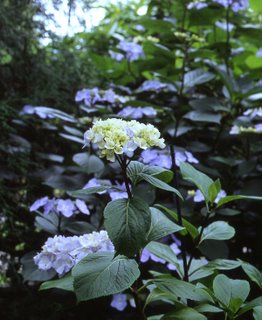
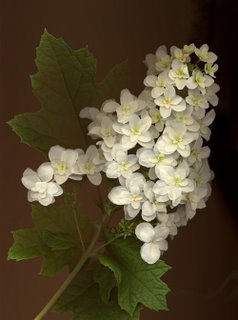
For most of my life I was a wall flower because I could not dance. I have come to identify with my over 35 hydrangeas as plants that nobody acknowledges as being important in a garden. They are seen as mostly ordinary plants. I have striking hostas and beautiful roses. Most of my roses peter out by mid July and some of the hostas are developing slug holes and their flower scapes look messy, unless I now cut them off. What's in bloom throughout my garden now and are pristine and crisp in their greeness? The hydrangeas are. I have come to appreciate their ease of cultivation, that they are pest free, and best of all, that they are faithful. I have pruned them incorrectly in my ignorant past but they always came back to greet me in the spring. The ill reputation of hydrangeas (hortensias in Victorian England) is perhaps due to the fact that most people have one kind, the blue or reddish mopheads of the Hydrangea macropylla type. I have many macrophyllas that are far from ordinary looking. Note the black stems and the delicate colouring of Hydrangea macrophylla 'Nigra' (top, right). I will never understand why it seems to be a secret that many hydrangeas (when their pollen is out) are intensely fragrant. They smell of honey. This is particularly the case with the Southern US species, Hydrangea quercifolia (bottom) (named after its oak[quercus] shaped leaves) and the Hydrangeas paniculatas . Some hydrangeas are not fragrant, just beautiful as Hydrangea macrophylla 'Blue Wave'being held here by Rebecca. I find it appropriate that Donald Duck's first chance to star in a cartoon (without having to compete with Mickey) was in 1937. But he did have to share a bit of his fame with an agressive but tender Hortense the ostrich. Sooner or later you just have to notice them even when they are growing well in dark corners where nothing else would.
The Feline Question
Tuesday, July 18, 2006
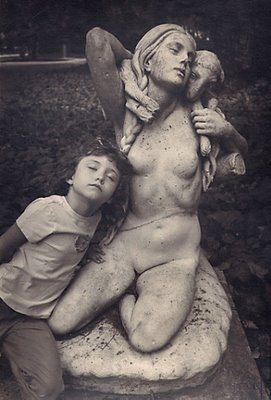
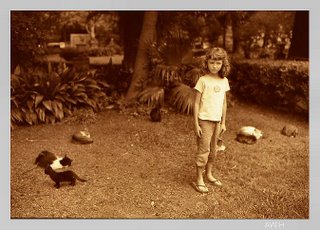
Since I was a child we always had some sort of pet in our house. Perhaps it was because of our large Buenos Aires garden. Uncle Tony would bring the pets that his wife, Sarita, would reject. They lived in an apartment. So I remember having a deer, a collie (she was called Sweetie), a giant brown unshorn poodle (Moro), rabbits, lizards, toads from Corrientes, a snake, an Argentine bird called a tero (our male had very large spikes on its shoulders and it had its wings broken by Moro), and a turtle that I unknowingly cooked when I set fire to a pile of fall leaves from our fig tree. My turtle hibernated under them. We had a parrot from the Province of Corrientes called Carlitos who lived for over 50 years when we gave him away. But we never had a cat. I remember insisting on bringing a white kitten that I found in a friend's house. My mother put the cat in her purse and we took the 60 bus home hoping we wouldn't be caught. The cat somehow disappeared soon after and I never asked my mother what happened.
A couple of years ago Rebecca, Rosemary and I went to Buenos Aires. We had to visit the Jardin Botánico Buenos Aires. Our reason was not necessarily to see the unusual plant specimens or the wonderful statue collection. We went to visit with the over 800 cats that live in the downtown park. They are obviously well fed. There are rumours that a little old lady feeds them. There are also rumours of the "disappeared" cats. If we Argentines can make people disappear efficiently I guess cats present no problem. It seems that the cats are rounded up and put in bags. They are then taken to the bank of the Rio de la Plata. Here they are, allegedly, clubbed to death.
When Porteños no longer want their unruly kittens, the Jardin Botánico is a neat solution. In the garden we saw all kinds of cats and even some exotic Siamese. Every few years Buenos Aires has a "feline question". This might explain the high turnover. While there, Rebecca and Rosemary must have petted and picked up every cat in sight.
Elvis Lives, Tony Avent & L.D. Braithwaite
Monday, July 17, 2006
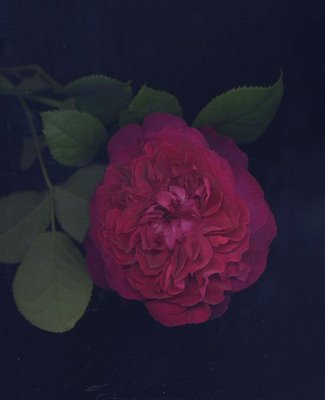
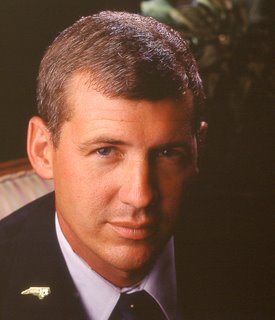
To market plants growers have always been very careful about naming plants. Some plants are named after people who may have discovered them in the wild or found them in a forgotten corner of a garden. Hosta 'sieboldiana 'Elegans'is named after German doctor Philipp Franz Balthasar von Siebold who in trips to Japan with Dutch traders in the 19th century may have discovered hostas while sifting through cow feed on Dashima Island in Japan. Some of my hostas have romantic names like Hosta 'August Moon' or poetic as in Hosta 'Robert Frost'. Others plants are named by their place of origin. For example I love our blue Verbena bonariensis because it reminds me of my native city or of the equally blue, grass, Elymus magillanicus which evokes my Argentine Patagonia. My skin-specialist doctor friend Jim Wilkins named a yellow hosta 'Ultraviolet Light'. But North Carolina grower Tony Avent (above, right) may have started a trend in going against the poetic or the pleasant naming of plants. He may have hit the mark with the difficult to find Hosta 'Elvis Lives' but what of Hosta 'Whitewall Tire' and Hosta 'Bubba'? Growers who decide to name plants after their relatives can get into trouble. My favourite living rose grower/hybridizer is Shropshire's David Austin. Many of his beautiful and beautifully named English Roses grace my garden. There is Fair Bianca ( Kate's, the shrew, kinder and gentler sister), William Shakespeare and Brother Cadfael. But why would he name one of the most glorious red/purple roses in my garden, L.D. Braithwaite, (above, left) after his brother in law?
Saving The Queen - William F. Buckley, Jr.
Sunday, July 16, 2006

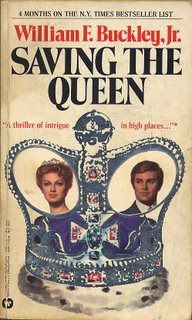
Sometime in the late 80s William F. Buckley, Jr. came to Vancouver to give a speech for the Vancouver Institute. It was held at the Hotel Vancouver. Harvey Southam the editor of Equity Magazine assigned me to photograph the author and editor of the conservative National Review. I cased the hotel and found that the nearest place with a bit of privacy was the piano in the central bar. Since the speech was in the morning it was empty. I set up my large camera on a tripod and prepared my lights. Buckley had told Southam that he would pose for the magazine. After the speech I brought Buckley to the bar and asked him to sit on the piano bench. When he saw the setup he told me, "Nobody told me about a photo session. You were supposed to snap me once or twice. No!" From my back pocket I pulled a copy of Buckley's first effort at fiction, Saving the Queen whose hero Blackford Oakes, a handsome CIA hero, reads the National Review and beds Her Most Britannic Majesty the Queen of England. "Could you autograph this for me?"I asked Buckley. He looked at me and without changing his sober expression he said, "All right, and you can take two pictures." This I did.
Spooks
Les, Drugs and Rock & Roll
Saturday, July 15, 2006
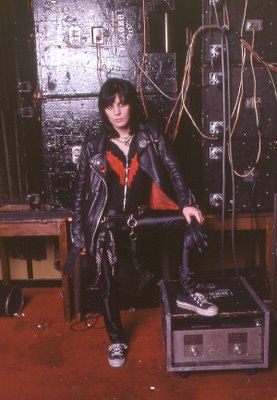
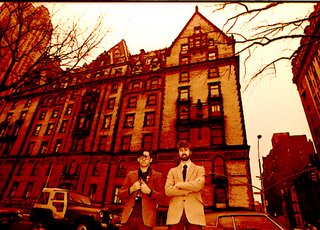
Before I moved with Rosemary, Ale and Hilary to Vancouver in 1975 my knowledge of rock and roll was limited to three acts, the Allman Brothers Band, The Beattles and Creedence Clearwater Revival. At the American high school in Mexico City where I had taught my students were appalled. One day they asked me if I had ever heard of Alice Cooper. They all sighed when I answered, "No, who's she?" So they gave me a copy of The Allman Brothers Band at Fillmore East and my introduction to rock and roll began. A "hip" Mexico City radio station ran a daily contest in which they played the Beattles and Creedence Clearwater Revival. At the end of the day listerners would vote in the "world's best band". Vancouver for me was definitely an innocent abroad situation. I knew no better. This was all corrected when I started working for Vancouver Magazine and was paired as the photographer to rock critic Les Wiseman's writing. He wrote his monthly In One Ear column in which he ( a snob of snobs) imposed his taste in rock & roll on innocents like me. Since I didn't know any better I learned well, and I too, was soon telling people, "If you feel that you have to listen to heavy metal there is only one band worth listening to and that's Motorhead." I just repeated what Wiseman had taught me. My daughters, who were becoming teenagers would say, "You mean you photographed Joan Jett today?" (top,left) They could not believe my good fortune. I tried to transfer my newly acquired wisdom on them and soon Hilary could recognize Johnny Thunders and Iggy Pop.
It was around the mid 80s that Les Wiseman and I decided to go to New York City to see if we could secure work with Rolling Stone. Both of us managed to show our stuff but in the end the editors of Rolling Stone (they all looked like Elvis Costello) told us that while they thought our work was excellent they were not interested in a story on Red Rider. The bad news did not prevent us from enjoying all the sites of the city including the Metropolitan, the Algonquin and the Guggenheim. But we also managed to see Johnny Thunders at CBGBs and Lou Reed at the Bottom Line. It was only years later through my daughters and now my granddaughter that I realize how lucky I was to be Wiseman's Lenso (that's what he called me)who always treated me as my attorney. One place we did go to, for different reasons, was the Dakota. He went because of John Lennon and I went because of Jack Finney's 1970 novel Time and Again. And we took no drugs. My attorney always suggested beer.
The Sukhoi Su-32"FN" & Alexandra Elizabeth Waterhouse-Hayward
Friday, July 14, 2006

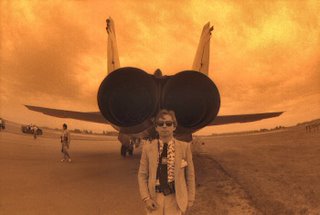
When my uncle Harry (my father's oldest brother was born) his father Harry Waterhouse Hayward had not yet married my grandmother Ellen Carter. My father argued that, technically, Harry, the son could not have Waterhouse as his middle name. This was an honour bestowed on the firstborn male and Harry was not a legitimate firstborn even though his father and mother married later. When I came along, my father George Hayward named me Jorge Alejandro Waterhouse-Hayward. In Argentina, until recently, babies could not have foreign names. The only way my father was able to insert Waterhouse as a middle name was with a hyphen and a 50 peso bribe. And that is how I became the first and last male of the family to have that surname. My daughters will not transfer the name to anybody and up to know I have two granddaughters. When Hilary Waterhouse-Hayward Stewart was pregnant for the second time I told her I would disown her if she had a little boy! What could I possibly do with a male grandson? I love my two little females, Rebecca and Lauren.
Perhaps my fondness for the little girls has all to do that my eldest daughter, Alexandra (Ale) Elizabeth Waterhouse-Hayward, besides being most beautiful and femenine, she also has the qualities of the perfect son. Consider that she can assemble barbecues and Ikea furniture in record times while I am hopeless at it. Best of all, Ale loves airplanes. Could I hope for more? She was so keen on airplanes that Patrick Reid gave her a job at the trade arm of the Abbotsford Air Show (Airshow Canada) for a few years and Ale was even hired by the Chilean Airforce to go to Santiago to help them there with an airshow. Going with Ale to an airshow was fun as she not only admired many of the airplanes that I admired, like the Sukhoi here, but also I must admit that after the F-100 Super Sabre I lost count with American fighter plane nomenclature. Ale can tell the difference between the F-15 and the F-18 and knows what a Tomcat looks like. One of my favourite photographs ever is one that Ale took of me with our favourite Sukhoi.
Allan Morgan, Sarah Rodgers, Humphrey Bogart, Juliet Stevenson
Thursday, July 13, 2006

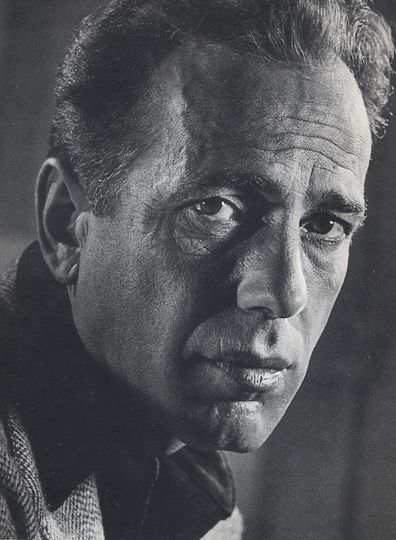
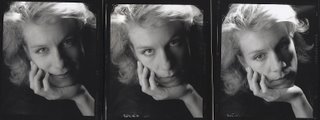
In the early 90s I had the luck to photograph British actress Juliet Stevenson in the Sun Room of the Vancouver Hotel. While it is obvious to most people that actors can act, we photographers are known for not being too swift. I was astounded how Ms Stevenson could change from one expression to another (after my instructions) and I have never forgotten the lesson. Fortunately there are other photographers, like Latvian born Philippe Halsman who knew this and wrote about it eloquently: From Halsman - Portraits, Harry N/ Abrams, Inc. New York, 1983:
I was standing on the dock waiting for Bogart. Far out on the sea I could see him alone in a small sailboat and I waved. When he noticed me his boat sailed toward me with such speed that I expected it to crash against the dock. But at the last moment Bogart suddenly veered it 90 degrees and the boat stopped in front of me.
Bogart leaped on the dock and shook my hand. "How would you like to shoot me," he asked, "as a detective or as a criminal?" "I want to photograph you as yourself, "I said without thinking that it would frighten him.
It is not easy to photograph an actor as himself, because often he has the feeling that his "self" is only an empty shell. He tried to hide it by assuming the personality of the different characters he habitually portrays. Very often this feeling of inner emptiness is the very reason for his becoming an actor in the first place.
The moment Bogart faced my camera he completely desintegrated. He could not act the tough guy as usual, because we both knew it would be phony. He did not know what to do with his hands, he could not look at my lens, he trembled with embarrasment, and his plight was so pathetic that I started talking to him as if to a frightened child. Eventually my conversation helped him to become calmer, his attack of jitters passed, and I got a few pictures that showed more than the mask he usually wore.
Many years later I read about Bogart's last days. He was dying of cancer and bearing it with incredible courage and toughness. Was this heroism the apotheothis of his acting career or had it become the man he had played most of his life?
Last week when I faced actors Allan Morgan and Sarah Rodgers I was again amazed at how actors can act on demand and my fortune that as a photographer I can be a temporary director. They were in my studio for a photograph that will accompany a preview article in today's Georgia Straight on their participation in the forthcoming Hoarse Raven Production of Angels in America. While most of us think that Roy Cohn was a despicable character, Morgan, who plays him, displayed for me a more sympathetic take. I told Rodgers, who is an angel, to save the man from himself. This she did and I took 6 or 7 pictures very quickly just in case the moment disappeared.
Flying Saucers & Sweet Peas
Wednesday, July 12, 2006

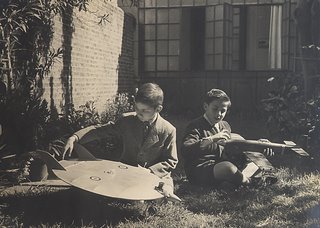
For as long as I can remember there has been a garden in my life. About 10 years ago I went to Rex Murfitt's garden in Victoria and Rex invited me into the kitchen for sandwiches. There was a vase of sweet peas on the kitchen table and when I saw them I realized I had not seen any since my youth. Yet their sweet scent was somehow recorded in my memory and when I put my nose to them I knew exactly what to expect. I was 8 or 9 when this photo was taken of my first cousin Wenceslao de Irureta Goyena and me (with the flying saucer) in our Buenos Aires garden on Melián 2770. Our neighbourhood was named Coghlan after the nearby train station by the same name. Our narrow but long garden had a wisteria and a variety of plum trees including one that was a cross between a plum and a cherry. We also had a khaki and I loved eating the unripe fruit. The puckering of my mouth was a novelty. Some years later we had a large garden on Sierra Madre Street in Mexico City. I was into explosives in those days and I mixed a large quantity of aluminum powder with pottassium chlorate, which my neighbourhood drugstore sold for I don't know what reason. I buried the mixture in a tin can under a hole in one of my mother's rose bushes. I triggered the explosion with a battery, a long cable, and a very thin piece of wire. The explosion sent the bush into the air. I got a sound spanking and a month later the bush flowered like it had never flowered.
Our garden on Athlone Street is now a bank of future memories for my granddaughters Rebecca (left) and Lauren (right) who posed for me last week. Lauren is holding a rose called Rosa 'Sexy Rexy'. I have tolerated its sporadic flowering because I had thought it was named after that notorious womanizer Rex Harrison. I have found out that this is not the case (that it is not named after Rex Harrison). Since explosive ingredients are no longer readily available I will have to live with Sexy Rexy, after all she reminds me of Lauren.
A Visit From The Garden Snobs
Tuesday, July 11, 2006

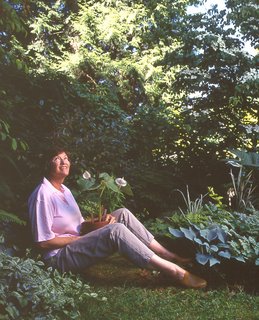
Opening a garden (left) has some strange rituals. Those who come cannot use the facilities and in most situations not even coffee or tea is offered. If there is more than one open garden in a tour, offering goodies could escalate into a goodies war. Since there are only two gardens in today's Vancouver Hardy Plant Group tour, I am going to make my famous iced tea (secret ingredient, Russian Caravan tea). The 400 plus enthusiasts that visited our garden on the city tour during two days a few weeks ago did not ruffle my wife's feathers all that much. This time around she is all nerves.
There are around 500 members of the Vancouver Hardy Plant Group and they are mostly mature women who are serious gardeners. The uncrowned queen is Pamela Frost(above right, holding an Arisaema candidissimum) whose garden on Elm Street(besides being exquisite) has the rarest and best plant specimens in Vancouver. Most of the plants in her garden (including a white rhododendron whose flowers have the scent of watermelon) she has patiently grown from seed. The VHPG holds no meetings. They simply visit gardens, publish an excellent bulletin and invite speakers (mostly British) to speak to us.
While the roses are fading we are hoping our visitors will appreciate our many varieties of hydrangeas, including an extremely rare Hydrangea serratifolia (Take that, Pamela!) whose flowers, before they open, resemble a ping pong ball. Rebecca and Lauren (my granddaughters) will be present in their flower-print dresses to act as hostesses when the ladies begin arriving at 6:30.
Tomorrow morning we will wake up to the usual depression mixed with relief of knowing that no more people will be coming to the garden unless we invite them. Should we let the garden go?
The Elegant Afghan
Monday, July 10, 2006
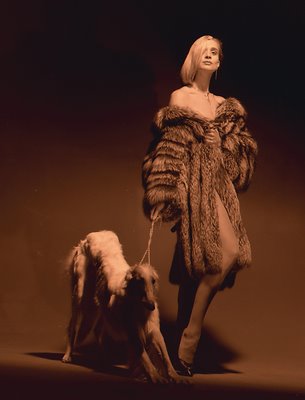
Sometimes I have that photographer's luck of being able to snap that one picture in the midst of others that are not in the least memorable. Here you see Daphne Pappas wearing a fur coat (her family sells furs, so this one is very expensive) panty hose and pumps. I gurantee she was not wearing anything else.
Giboshi Man - Wolfram George Schmid
Sunday, July 09, 2006


I first met W. George Schmid at the American Hosta Socieity's National Convention in Columbus, Ohio in 1992. At first I was afraid of approaching the tiny and short man with the large glasses and the strange German/Southern accent. But I soon learned that he was one of the friendliest of the hosta gurus in attendance. He told me that he was an engineer who had designed rocket launching platforms for NASA. When moved to Atlanta in the 60s he was confronted with one of his toughest "technical" problems. He seemed to be unable to grow anything in his red Atlanta clay garden. This was the case until he bought some Hosta 'Honeybells'. This is an ordinary (but has fragrant flowers) hosta of no particular merit except that it grew well in red clay. Schmid was hooked. He researched the plants for 15 years and realizing that most of them (the Giboshi as hosta are called)came from Japan he learned Japanese. In 1991 he published the ultimate book on hosta, The Genus Hosta.
Schmid represents a lonely faction within the American Hosta Society. He loves green plants and thinks that the multi-variegated forms are difficult to place in a garden. These plants often revert to green and he calls them "dishonest" as oposed to his "green" friends.
Because of his knowledge in all things hosta Schmid is in charge of Nomenclature (with a capital N!). He speaks with such precision that I would love to see him dressed up as the Swedish Linnaeus who invented the system.
But as technical and precise as this man is he has taught me much that has to do with the design of a garden. Once he confessed to me that he talked to his plants, I didn't feel so embarrased that I did, too. His concept of "shoulder to shoulder" gardening, in which individual plants compete for space so that by the end of May I cannot see a square inch of dirt in my flower beds, is pure Schmid. It was Schmid who pointed out (it wasn't obvious to me then) that by placing a "blue" hosta next to a "gold" hosta the gold and blue plants would each be more intense in their colour. My Argentine painter friend, Juan Manuel Sanchez was almost speechless when I told him. "You mean you didn't know this? " He further advised me to bring in a third colour purple.
But Schmid's influence and legacy is increasing in my garden as I eschew bold hostas and select plants with that infinite variety of green that calms the nerves and brings peace to the soul.
Scrotums, Ravens and Alexis MacDonald
Saturday, July 08, 2006
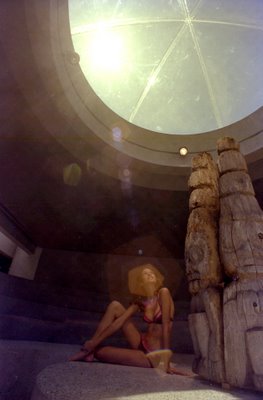
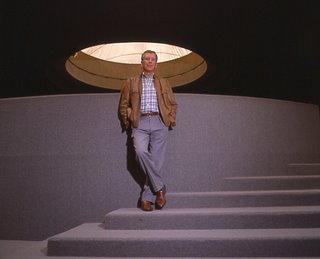
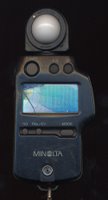
Vancouver's Museum of Anthropology has always been a special place for me. Many things have happened to me there and not all of them good. It was last year that I was taking pictures of the Borealis Quartet in the main hall and a light stand came crashing down on the one spot in the carpet where I had left my $500 Minolta IV-F flash meter. It was destroyed. It was here in 1984 where I first photographed Arthur Erickson (who designed the museum). Erickson chose to pose where Bill Reid's carving Raven and the First Men was placed under a dome. The angle I had picked made the carving disappear from sight and Architect and building were alone without the "competition" of any aboriginal artifacts. It was at this very carving where my granddaughter Rebecca, two years ago when she was 7, first observed an item of the male genetalia that made her very curious. I had to explain to her that it was called a scrotum. Months later I took Rebecca to the Seattle Art Museum to see a show of ancient Greek artifacts including some lovely vases. Upon seeing a vase Rebecca loudly said, "Look, you can see their scrotums!" The hall was full and everybody stared at us.
But it was in 1978, before Bill Reid had carved his Raven, that I first took a picture in the museum under the dome. I asked the guard what the restrictions were. He said, " No flash and no tripod." With me, I had Blanche MacDonald's beautiful daughter, Alexis. She removed her dress and I was able to take two photographs before we were thrown out. I remember telling the irate guard, "But I used no tripod or flash."
The Dame, The Two Gentlemen & A Cat
Friday, July 07, 2006
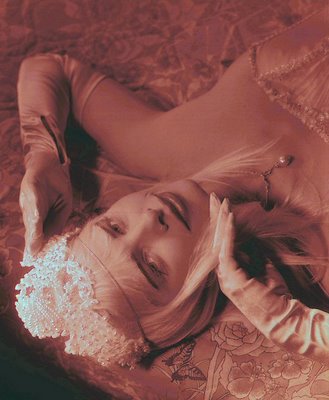
In September 1990 when Hungarian-born Illona Staller came to Vancouver to strip at the Marble Arch, I knew I had to take her photograph. She was better known as Cicciolina (cuddly in Italian and at 5 foot 7 inches she was). She had risen in Italian politics from pornodiva, to pornocandidata to pornodeputata. I went to Charles Campbell, editor of the Georgia Straight, and pitched the story. Amazingly he was interested. There was more humour in our publications in those years. Or at least, Charles didn't take his job as seriously as editors do now. I asked Tony Ricci, the owner of the Arch, if he could arrange for an interview. I remember exactly what he told me, "For you, Alex, anything. You will interview her first and I will make the Province and the Vancouver Sun reporters and photographers wait for you to finish. You willinterview her in our best room, the one that has the butterfly bed cover." And so it was. The day of the interview I was shown into room 315 while the Sun and Province writers and photographers waited outside. My piece ran with this picture.
What I remember fondly is our intimate dinner at Umberto's. Cicciolina invited me. The folks at Umberto's refused to accept her money. Everybody stared at us. Cicciolina was dressed like Queen Guinevere. Our waiter may have suspected that while Cicciolina was an expert at baring her breasts in public, she was no wine expert. So when he poured the wine and Cicciolina immediately said, "Ordinario," he returned with the good stuff. I had pasta and Cicciolina ordered the rabbit. Umberto came to us and asked us if we had liked our meal. We looked at each other and came up with the same idea. We put our hands by our ears, with the index fingers up, and we meowed in unison.
Cesar's Light
Thursday, July 06, 2006
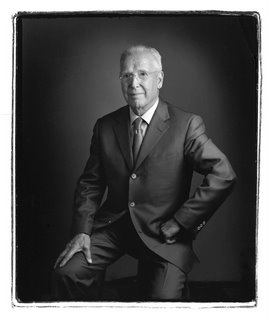

A couple of years ago I photographed architect Arthur Erickson in my studio. He is always a delight. I love his urbanity. But this time I had him stumped with my question. I asked him which was the most famous building in Vancouver by an internationally known (but not Canadian) architect. Arthur did not know. I pointed out my window to the white building across the street which is Simpson Sears. Tucumán (Argentina) born Cesar Pelli designed it (formerly Eaton's) and the Toronto Dominion Tower which faces West Georgia. Both were built in 1973.
When I first came to my present studio some 15 year ago I fell for the special light reflected into it by Pelli's one-city-block-long white wall. In a recent review of my show of roof gardens at the Pendulum Gallery, a block from the TD Tower, Vancouver Sun columnist Malcolm Parry somehow connected it with undraped women to my wife's chagrin (I was delighted). This is what he wrote:
Alex Waterhouse-Hayward's photographic exhibition, Secret Gardens: Vancouver's Hidden Rooftops, is worth a visit to the Georgia-at-Hornby-Pendulum Gallery. As you'd guess, it pictures luxuriant stretches of greenery usually seen only by the occupants of even higher buildings.
Utterly unknown to downtowners was the Robson-off-Granville studio in which Waterhouse-Hayward long photographed female models as undraped as the second-floor facility's windows. No one could look in because the Sears (earlier Eaton's) department store facade across the street has no windows at all. But the blank, south facing wall perfectly reflected sunlight to give the photographer the softly diffused glow - and privacy - he cherished.
Mac erred in that I am still in that studio and I do have curtains. I ignored Pelli's light (much to Arthur's delight)and I used my own for this portrait of Erickson. But my granddaughter Rebecca got the full white wall treatment in August 2005.
The Essence Of A Woman
Wednesday, July 05, 2006
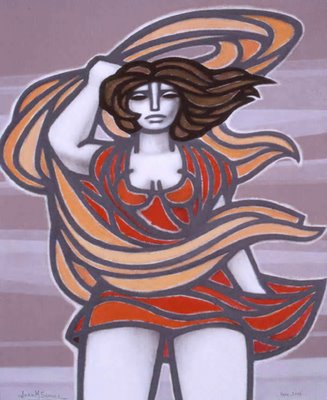
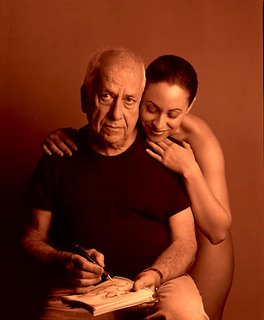
Argentine painter Juan Manuel Sanchez has a show of his work, (Wind Series)which opens this Saturday at the Ian Tan Gallery. Juan and I are pals.
I don't always photograph women. I have been known to have shot sewing machines for the CBC movie critic Rick Staehling in my past. This is why I admire and love Juan. He is obsessed with the idea of woman. That's about all he paints from about noon to late at night. Every one of his paintings is a problem to be solved. It's as if each painting of a woman is a woman to be discovered, studied, learned and understood. Every painting is a Platonic essence. Juan discards everything he can much like a Phileas Fogg desparately burning all available furniture on board his ship home. I asked him once if some day he will draw a line on a canvas and say, "That is woman." His answer was, "Perhaps." The woman illustrated here he first saw on a street on windy Avenida de Mayo in Buenos Aires. The wind, a hot wind from the pampas is called a pampero or a sudestada. The striking woman got off a colectivo (bus) when the wind picked up and her skirt flew. Juan (photo on right) poses with one of his muses, Linda Lorenzo. You can meet Juan between 2 and 4 this Saturday at 2202 Granville.
Ian Tan Gallery
Evelyn Hart
Tuesday, July 04, 2006

As a magazine photographer in Vancouver for 30years I have taken pictures of interesting people from actors like Vincent Price and Helena Bonham Carter to politicians like John Turner and writer William F. Buckley. But in 1995 I got to photograph ballerina Evelyn Hart. While I had attended dance performances before, I had never been exposed to a ballerina like this one. At the end of two special days I fell in love with dance and with Hart.
I first saw Evelyn Hart in December 1995 at Vancouver's Metropolitan Hotel, in what had been the billiard room of the old Mandarin Hotel. She was like an origami swan, all straight lines. When I saw her dance the next day in the Nutcracker, she reminded me of Claire Bloom in Limelight, playing the suicidal ballerina who is saved by the washed-up clown played by Charlie Chaplin. I had marveled at other ballerinas and been wowed by their technique, but here was a ballerina whose brilliant technique played second fiddle to her ability to act. I have seen quite a few performances of Prokofiev’s Romeo and Juliet but after seeing Hart’s version I cannot imagine any other dancer in the part.
For two days, I was privy to a remarkable and extended interview with Hart by dance journalist Shannon Rupp. I felt I was hiding behind a priest hearing a confession. On the second day, in her Queen Elizabeth Theatre dressing room, the then-39-year-old ballerina expressed anxiety about her career and the ticking clock. It was amazing to see Hart open up and reveal this not only to Ms Rupp but to also to me. It was at that point that I decided to take my portraits. Because of Hart's generosity I was rewarded with one of the best portraits I have ever taken. Everything in it, including the hammer with which Hart pounds her shoes into softness was as it was.
I cry when Hart is on stage. I don’t notice the other dancers. I only have eyes for her. I make a point of getting a seat in at least the fourth row (binoculars just won't do), and from there Hart is the ultimate Juliet - especially in the scene where she is to take the good friar's potion that will put her in a catatonic sleep. Hart dances en pointe bourree forwards and backwards, oh so exquisitely as she agonizes over her decision. Having taken Hart's portrait at rest I realize that no matter how good a picture of her I might take of her dancing it would pale in comparison to what it is when a ballerina opens up her heart, just for me, in her dressing room.
Spaniards have a word, fenómeno, for talent that has no rational explanation. Manolete, Casals, Evelyn Hart.
The Adirondacks
Monday, July 03, 2006
-772445.jpg)
When our neighbour Jim McGivillray died (in his 80s) 8 years ago while playing golf, his wife Barbara stayed on for a while tending her garden. But she decided to sell and offered a couple of folding Adirondack chairs to us for $15 each. They had been stored in their garage since the 60s. Rosemary particularly liked the peach colour of one and the greenish blue of the other. They seemed to blend in our garden. But she has been nagging me to re-paint them for years in the exact same colour. The time came a couple of weeks ago when my painter friend Juan Manuel Sanchez almost fell from one of the chairs when rusting screws loosened. I sanded the chairs and used stainless steel screws. I went to our local lumber store where they matched Jim's paint job. That colour will not show here since this picture that I took of Rebecca yesterday is a scanned Polaroid peel and colours are never predictable.
Death Does Not Take A Holiday (Canada Day)
Sunday, July 02, 2006
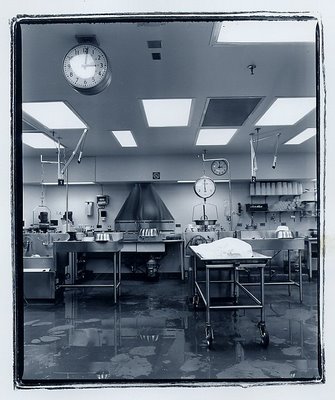
I am cheating as today's blog I wrote yesterday. And I am writing it today (yesterday) so I can justify the headline title above. In March, 1994. Vancouver Magazine art director Tom Brown asked me to photograph the city morgue at the Vancouver General Hospital. I decided I was going to avoid the big toe peaking from a body on a slab with the attached tag and the impersonal number that death brings to a human being that was. I decided, instead, to treat the place as a clean, sterile room that would suggest the surgical tools of the trade. They asked me what I needed. I told them I wanted them to wet the floor. This they did. And I snapped this picture using the sharpest film known to man (and woman), Kodak Technical Pan that resolves in excess of 200 lines per millimeter.
A Fading William Shakespeare
Saturday, July 01, 2006
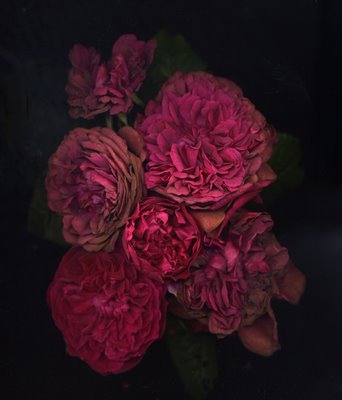
For two days the subject here has been death and the celebration of life. Today I will celebrate death, the slow fading kind. With some roses, particularly with old gallicas. this fading is most beautiful with the crimson and crimson/red ones. As they age they go purple and sometimes they bleach into metalic gray. Rosa 'William Shakespeare' is an English Rose that was introduced by Shropshire rose man David Austin in 1987. For most, this gallica type (unlike gallicas it repeat blooms) was a poor performer and disease prone. In the year 2000 Austin introduced an improved but odd-named Rosa 'Shakespeare 2000' and took the 1987 version out of the market. In my garden the original William Shakespeare is a terrific survivor and is one of Rebecca's favourites because of its sweet old rose perfume and its startling rich crimson colour. The blooms persist and the petals seem to be almost indestructible. Here is proof that in fading, William Shakespeare is more than Gertrude Stein's, "A rose is a rose is a rose."






